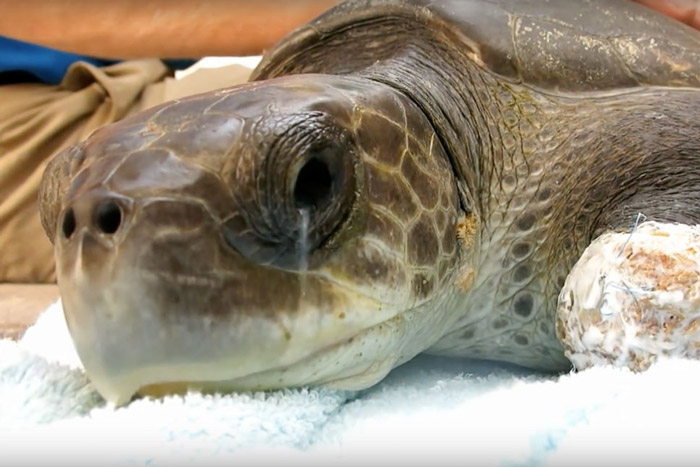Sea turtles get rid of excess salt through specialized glands near their eyes. These glands excrete a salty solution, resembling tears.
Sea turtles live in saltwater environments, ingesting large amounts of salt. To maintain their internal balance, they rely on specialized salt glands. These glands, located near their eyes, effectively excrete excess salt. This adaptation is crucial for their survival in ocean habitats.
The salty solution produced often looks like tears, helping them keep their salt levels in check. Sea turtles’ ability to manage salt intake is a remarkable feature of their physiology. It ensures they thrive in their marine ecosystems. Understanding this process highlights the fascinating adaptations of sea turtles. Their unique salt regulation mechanism is a testament to their evolutionary success.

Introduction To Sea Turtle Physiology
Sea turtles are fascinating creatures with unique adaptations. Their physiology helps them thrive in marine environments. One key adaptation is their ability to manage salt intake. This is crucial for their survival.
Salt Intake In Marine Life
Marine animals constantly ingest saltwater. For sea turtles, this happens while eating or drinking. They need special mechanisms to handle the excess salt.
Unique Challenges For Sea Turtles
Sea turtles face unique challenges living in the ocean. They must avoid dehydration while managing salt levels. Unlike fish, they can’t excrete salt through their gills.
Sea turtles have specialized glands near their eyes. These glands, called salt glands, help them excrete excess salt. The salt glands are more efficient than human kidneys at removing salt.
Sea turtles often appear to be “crying”. This is their way of expelling salt from their bodies. The “tears” are actually a salty solution.
| Challenges | Solutions |
|---|---|
| Ingesting saltwater | Salt glands near eyes |
| Avoiding dehydration | Efficient salt excretion |
Sea turtles rely on their salt glands for survival. This adaptation is vital for their life in the ocean.
The Role Of Specialized Glands
Sea turtles live in salty ocean water. They need to remove excess salt from their bodies. Specialized glands help them do this. These glands are crucial for their survival.
Anatomy Of Salt Glands
Sea turtles have salt glands near their eyes. These glands are called lachrymal glands. They are larger and more developed than in other animals. These glands are key to managing salt levels.
| Feature | Description |
|---|---|
| Location | Near the eyes |
| Size | Larger than in other animals |
| Function | Remove excess salt |
Functioning Of Salt Excretion
Salt glands filter salt from the blood. They turn it into a concentrated solution. This solution is then excreted.
- Blood carries salt to the glands.
- Glands filter and concentrate the salt.
- Salt is excreted as a briny solution.
Sea turtles often appear to be “crying.” This is just the salt being excreted. It helps them stay healthy in salty water.
Adaptations For Osmoregulation
Sea turtles live in salty ocean water. They need to remove excess salt. This process is called osmoregulation. Sea turtles have unique adaptations for this purpose.
Evolutionary Perspective
Sea turtles evolved to survive in salty oceans. Their bodies have special glands. These are called salt glands. Salt glands help remove excess salt from their bodies. This adaptation is crucial for their survival.
Their kidneys also play a role. Sea turtle kidneys are efficient. They produce very salty urine. This helps get rid of excess salt. These adaptations evolved over millions of years.
Comparison With Other Marine Animals
Many marine animals have similar adaptations. Fish, for example, have gills. Gills help remove salt. Fish also drink lots of seawater. They filter out the salt before it enters their bodies.
| Animal | Adaptation |
|---|---|
| Sea Turtles | Salt glands, efficient kidneys |
| Fish | Gills, drink seawater |
| Seabirds | Salt glands in beaks |
Seabirds also have salt glands. Their salt glands are in their beaks. This allows them to drink seawater. The salt glands remove the excess salt.
Marine mammals like whales and dolphins have different adaptations. They do not drink seawater. They get freshwater from their food. This helps them manage salt levels.

The Salt Excretion Process
Sea turtles live in salty oceans. They drink seawater to stay hydrated. But how do they get rid of excess salt? This process is fascinating and unique to sea turtles. Let’s explore the salt excretion process.
Mechanism Of Action
Sea turtles have special glands called lachrymal glands. These glands are located near their eyes. The glands filter out the salt from the seawater they consume. The excess salt mixes with tears. Sea turtles then excrete the salty tears from their eyes.
This mechanism ensures the turtles stay hydrated. It also prevents salt from building up in their bodies. The lachrymal glands work continuously. This helps sea turtles survive in the ocean.
Energy Consumption And Efficiency
The salt excretion process requires energy. Sea turtles use a part of their food energy for this. The process is highly efficient. It ensures minimal energy loss.
Sea turtles have evolved to optimize this process. They can balance their energy needs and salt excretion. This balance is crucial for their survival.
Despite the energy cost, the process is vital. It allows sea turtles to thrive in salty environments.
| Component | Description |
|---|---|
| Lachrymal Glands | Specialized glands near the eyes for filtering salt. |
| Salt-Tears | Excreted tears containing excess salt. |
| Energy Use | Energy from food is used for the excretion process. |
Understanding the salt excretion process helps us appreciate sea turtles. Their ability to survive in salty water is amazing. These mechanisms ensure their continued existence in our oceans.
Behavioral Strategies
Sea turtles have fascinating ways to deal with excess salt. These strategies help them survive in salty oceans. Let’s explore some of these behaviors.
Feeding Habits And Salt Intake
Sea turtles eat a variety of foods like jellyfish, seaweed, and small fish. Different foods have different salt levels. Turtles choose foods with less salt to avoid too much intake. Their diet helps them manage salt levels efficiently.
| Food Type | Salt Content |
|---|---|
| Jellyfish | Low |
| Seaweed | Medium |
| Small Fish | High |
Migration And Salinity Levels
Sea turtles migrate to different parts of the ocean. They move to areas with lower salinity when needed. This helps them avoid high salt levels. Migration is a key behavior for salt regulation.
- Move to fresher waters
- Avoid high-salinity areas
- Seasonal migration patterns
Understanding these behaviors is important. It shows how sea turtles adapt to their salty environment. These strategies are crucial for their survival.
Environmental Impact On Salt Regulation
Sea turtles have a unique way of managing salt. They drink seawater and excrete the excess salt through special glands. This process is vital for their survival. Environmental changes can disrupt this delicate balance. Pollution and climate change are major threats. Let’s explore how these factors impact salt regulation.
Effect Of Pollution
Pollution in the ocean harms sea turtles. Chemicals and plastics enter their bodies. These toxins affect the salt-excreting glands. Turtles struggle to get rid of salt. This leads to health issues. Polluted water also disrupts their natural habitat. It makes it harder for turtles to find clean water.
- Plastics block their glands.
- Chemicals poison their systems.
- Dirty water confuses their senses.
Climate Change Considerations
Climate change affects sea turtles in many ways. Warmer waters stress their bodies. This impacts their salt regulation abilities. Rising temperatures also change their habitat. Sea levels rise and beaches erode. Turtles lose nesting grounds. This adds to their stress.
| Climate Change Factor | Impact on Turtles |
|---|---|
| Warmer Waters | Stress and salt regulation issues |
| Rising Sea Levels | Loss of nesting grounds |
| Beach Erosion | Reduced habitat |
These changes make survival harder for turtles. They face more threats every day.
Research And Observations
Understanding how sea turtles manage their salt levels is fascinating. Researchers have made significant strides in this area. They use various methods to study these magnificent creatures.
Studies On Sea Turtle Health
Scientists have conducted numerous studies on sea turtle health. These studies help us understand how sea turtles get rid of excess salt.
Sea turtles consume a lot of saltwater while eating. Their bodies need to remove this excess salt to stay healthy.
| Study | Findings |
|---|---|
| Marine Biology Research | Sea turtles have specialized glands to excrete salt. |
| Environmental Science Journal | Salt glands are located near the eyes. |
Technological Advancements In Monitoring
Technological advancements have improved how we monitor sea turtles. Researchers now use GPS and tracking devices.
These devices help scientists gather data without disturbing the turtles.
- GPS tracking provides real-time location data.
- Biometric sensors monitor health metrics.
- Remote cameras capture behavior in natural habitats.
These tools have revolutionized sea turtle research. They offer insights into salt management and overall health.
Conservation Efforts
Sea turtles face many threats, but conservation efforts help ensure their survival. Let’s explore some key conservation strategies that protect these magnificent creatures.
Protecting Sea Turtle Habitats
Sea turtles need safe places to live and nest. Conservationists work to protect their habitats. They create protected areas where sea turtles can thrive.
- Marine protected areas
- Beach protection zones
- Coral reef conservation
These areas keep sea turtles safe from harm. They also help maintain healthy ecosystems. This is vital for sea turtles and other marine life.
Public Awareness And Education
Educating people about sea turtles is very important. Public awareness campaigns teach people how to help. Schools and communities learn about sea turtles and their needs.
- School programs
- Community workshops
- Media campaigns
People learn why sea turtles are important. They understand how to protect them. This knowledge leads to better conservation practices.
By spreading awareness, everyone can contribute to sea turtle conservation. Simple actions make a big difference. For example, reducing plastic use can save sea turtles.
Conservation efforts are crucial for sea turtle survival. Protecting their habitats and educating the public are key strategies. Together, we can ensure these incredible creatures continue to thrive.

Frequently Asked Questions
How Do Sea Turtles Excrete Salt?
Sea turtles excrete salt through specialized glands near their eyes. These glands filter out excess salt from their bloodstream. The salt is then expelled as salty tears, helping them maintain balance.
How Do Turtles Get Rid Of Excess Salt?
Turtles get rid of excess salt through specialized glands near their eyes. These glands excrete salty tears.
How Do Marine Reptiles Get Rid Of Excess Salt?
Marine reptiles expel excess salt through specialized glands. These glands are located near their eyes or nostrils. Salt is excreted as a concentrated fluid. This helps them maintain proper hydration.
How Do Turtles Handle Salt Water?
Turtles handle salt water using specialized glands near their eyes. These glands excrete excess salt. Sea turtles drink salt water and filter out the salt. This adaptation helps them survive in marine environments.
Conclusion
Sea turtles have unique glands to expel excess salt from their bodies. These glands ensure their survival in salty oceans. Understanding this process highlights the remarkable adaptations of sea turtles. It also emphasizes the importance of protecting their habitats. By preserving marine environments, we support these incredible creatures and their natural behaviors.





Leave a Reply